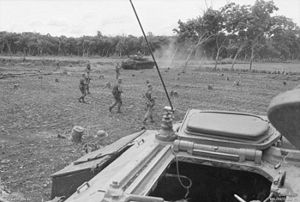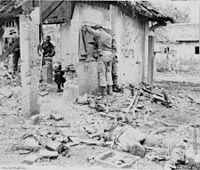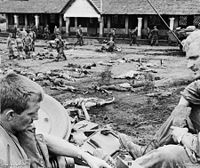- Battle of Binh Ba
-
The Battle of Binh Ba (6–8 June 1969), also known as Operation Hammer, was a hard fought, but one-sided, battle during the Vietnam War. The action occurred when Australian Army troops from the 5th Battalion, Royal Australian Regiment (5 RAR) fought a combined communist force of North Vietnamese Army and Viet Cong in the village of Binh Ba, 5 kilometres (3.1 mi) north of Nui Dat in Phuoc Tuy Province. The battle was unusual in Australian combat experience in Vietnam as it involved fierce close-quarter house-to-house fighting. In response to communist attempts to capture Binh Ba the Australians assaulted the village with infantry, armour and helicopter gunships, routing the Viet Cong and largely destroying the village itself. Such battles were not the norm in Phuoc Tuy, however, and the heavy losses suffered by the communists forced them to temporarily leave the province. Although the Australians did encounter communist Main Force units in the years to come, the battle marked the end of such large-scale clashes, and ranks as one of the major Australian victories of the war.[2]
Contents
Prelude
Situated north of the 1st Australian Task Force (1 ATF) base at Nui Dat on the western side of Route 2, the village of Binh Ba had a population of around 3,000 people—mainly farmers and rubber plantation workers.[3] Tidy and rectangular in shape, and mainly constructed of solid brick and tile, Binh Ba was well known to the Australians.[4] Indeed during 5 RAR's first tour in Vietnam a rifle company and a mortar section had been briefly stationed within the village itself.[5] This strategy proved to be a deterrent to the Viet Cong tax collectors and assassination squads taking control of the village.[6] The drain on the finite resources of the small Australian force proved to be too much however, and the village was later left to the protection of South Vietnamese Regional Forces.[5]
In an attempt to demonstrate that they could move freely with in the province, a combined communist force including a company from the 33 NVA Regiment, elements of the Viet Cong D440 Provincial Mobile Battalion, the Binh Ba and Ngai Giao Guerrilla Squad and the Chau Duc District Company had occupied Binh Ba on the evening of 5–6 June 1969. [2][7] In response, South Vietnamese forces were sent from Duc Thanh the following morning. Initial intelligence suggested that a group of about platoon strength had infiltrated the village.[2] Meanwhile during a separate operation 6 RAR had also been engaged in a heavy contact several kilometres north of the task force base and at 08:00 on 6 June, an Australian Centurion tank and an armoured recovery vehicle moving through Binh Ba to assist 6 RAR were fired upon. A rocket propelled grenade struck the Centurion penetrating the turret, and causing damage to the tank and severe injuries to one of the crewman. The district commander subsequently asked 1 ATF for assistance in clearing Binh Ba.[8]
Battle
The 1 ATF Ready Reaction Force consisting of D Company 5 RAR, a troop of tanks from 1st Armoured Regiment and a troop of armoured personnel carriers from 3rd Cavalry Regiment— under the command of Major Murray Blake— subsequently reacted to the incident.[9] Meanwhile elements of the 1st Battalion 33 NVA Regiment took up defensive positions within the village and prepared to fight to the death. By 10:30 the Australians approached Binh Ba from the south, and were engaged by a volley of RPG fire from a row of houses.[7] After clearing evacuating much of the town's population, D Company assaulted the village from east to west following preparation from helicopter gunships of No. 9 Squadron RAAF. South Vietnamese Regional Force troops were deployed into blocking positions. Four tanks led the assault, with the infantry remaining mounted in the APCs following behind.[9]
The Australians reached the edge of the village at 11:20, coming under light fire. Initially the tanks were effective for close action, however by the time the marketplace had been reached in the centre of the town concealed RPG 7s had caused external damage to two Centurions, whilst another was penetrated. Within an hour, three of the four tanks used in the initial assault were disabled through damage and crew casualties. It became clear that the initial assessments of communist strength had been inaccurate, and was probably closer to a battalion than a platoon. In addition helicopters overhead reported another large enemy force of up to 60 moving to the south and west. Blake subsequently decided swing the attack left, in order to clear the southern edge of the town before moving out to western side of Binh Ba. As the Australian armour moved through the rubber trees they clashed with a company forming up to counterattack, inflicting heavy casualties on the communists in the process.[9]
By 14:00 the Australians were bolstered by additional troops from B Company 5 RAR, under Major Rein Harring, which took up blocking positions to south and east. The Commanding Officer of 5 RAR, Lieutenant Colonel Colin Khan, now assumed command of the battle. With a fresh troop of tanks together with APC support, D Company conducted a second assault on the village, this time with the infantry leading. One tank and two Armoured Personnel Carriers accompanied each platoon in close support.[9] The lead platoon made contact with the enemy immediately and the advance was slow due to the need to clear every house. The communists occupying the houses fired on the Australians from the windows and doorways before withdrawing into tunnels as they passed. An Australian soldier—Private Wayne Teeling—was killed by a shot through the neck as his team approached the first line of houses. A tank fired one round of HE into the building occupied by the Viet Cong. The house exploded, and the clearing team assaulted immediately. Six dead were found in the ruins.[10]
This type of action was typical all along D Company's assault line and every time the Australians received fire from a building, tank rounds were used to breach the walls and a small team of infantry would conduct room clearance until all resistance was quelled.[9] During the fighting some of the VC had discarded their uniforms and weapons and attempted to mingle with the pockets of civilians that were unable to escape. The continued presence of civilians in the village required the Australians to expose themselves to extreme danger while trying to usher these groups to the rear of the battle zone. Others tried to flee the village, or hide in the small air raid bunkers attached to every house.[11] The fighting continued all afternoon and only ended at last light. With Binh Ba still insecure, D Company and their armoured support subsequently occupied a defensive harbour for the night, exhausted by the fighting.[9] Overnight B Company killed two VC trying to break out to the south.[11]
At 06:00 on 7 June B Company intercepted a communist company attempting to enter the town, and after blocking the exit and entry routes—and again supported by armour—they forced them to withdraw. On the second day the clearing of the village continued. D Company, with a platoon from B Company attached, meet sporadic resistance from a number of small groups still holed up in the village. To fully clear the village every bunker, house and any likely areas of concealment had to be searched. Later in the morning South Vietnamese forces in the northern hamlet of Duc Trung came under attack, and B Company and the Assault Pioneer Platoon were deployed to provide assistance.[9] Indeed most of the action now centred on Duc Trung, with a helicopter reporting a force of up to 80 communist troops moving between the buildings. With the pioneers blocking to the south a Regional Force reaction company cleared the village, however the VC had already left.[12] By 13:00 heavy firing again broke out in Duc Trung, with the South Vietnamese rapidly over run by over a hundred communists. Accurate artillery fire was effective in stabilising the situation, however, and B Company with a troop of tanks sweep the hamlet.[13] During the afternoon D Company continued to clear Binh Ba and further close-quarter fighting followed before the Australians withdrew to allow the South Vietnamese to complete the clearance. By the evening the village was secure, and B and D Companies adopted blocking positions overnight.[2]
Aftermath
Operation Hammer concluded by 09:00 on 8 June with one final sweep carried out that morning to ensure that Binh Ba was clear.[2] By this time a large communist force had been defeated by the Australians, and the village practically destroyed.[14] Indeed so badly damaged was Binh Ba that the villagers were subsequently resettled.[13] Despite efforts to clear the village of civilians before the battle, a large but unknown number of civilians had undoubtedly died during the fighting. This fact, coupled with the one-sided casualty count, later led to claims in the media of an Australian atrocity.[15] One Australian had been killed and 10 wounded, while communist losses included at least 107 killed, six wounded and eight captured.[1]
The battle was one of the major victories of the Australians in Vietnam and although they would occasionally encounter communist Main Force units in the future, it effectively marked the end of such large scale clashes.[2] Indeed, as a result of such heavy losses suffered at Binh Ba the North Vietnamese were temporarily forced to move out of Phuoc Tuy and into the adjoining province of Long Khanh.[2] The Royal Australian Regiment, the 3rd Cavalry Regiment and 1st Armoured Regiment were subsequently awarded the battle honour 'Binh Ba', one of only five awarded to Australian units during the war.[16]
Notes
- ^ a b c McKay and Nicholas 2001, p. 212.
- ^ a b c d e f g Coulthard-Clark 2001, p. 291
- ^ O'Neill 1968, p. 30 and 66.
- ^ Battle 1970, p. 51.
- ^ a b McNeill 1993, p. 298.
- ^ O'Neill 1968, pp. 193–194.
- ^ a b Odgers 1999, p. 349.
- ^ Coulthard-Clark 2001, p. 289–290.
- ^ a b c d e f g Coulthard-Clark 2001, p. 290.
- ^ McKay and Nicholas 2001, p. 209.
- ^ a b Battle 1970, p. 55.
- ^ Battle 1970, p. 56.
- ^ a b Battle 1970, p. 57.
- ^ Coulthard-Clark 2001, p. 289.
- ^ Ham 2007, p. 484.
- ^ Horner 1990, pp. 459–461.
References
- Battle, M.R. (1970). The Year of the Tigers: The Second Tour of 5th Battalion, the Royal Australian Regiment in South Vietnam, 1969–70. Brookvale: Printcraft Press. ISBN 0855810009.
- Coulthard-Clark, Chris (2001). The Encyclopaedia of Australia's Battles (Second ed.). Crows Nest: Allen and Unwin. ISBN 1865086347.
- Ham, Paul (2007). Vietnam: The Australian War. Sydney: Harper Collins. ISBN 9780732282370.
- Horner, David; ed (1990). Duty First: The Royal Australian Regiment in War and Peace (First ed.). North Sydney: Allen and Unwin. ISBN 004442227X.
- McKay, Gary; Graeme Nicholas (2001). Jungle Tracks: Australian Armour in Vietnam. Crows Nest: Allen and Unwin. ISBN 1865084492.
- McNeill, Ian (1993). To Long Tan: The Australian Army and the Vietnam War 1950–1966. The Official History of Australia's Involvement in Southeast Asian Conflicts 1948–1975. St Leonards: Allen and Unwin. ISBN 1863732829.
- Odgers, George (1999). 100 Years of Australians at War. Sydney: Lansdowne. ISBN 186302669X.
- O'Neill, Robert (1968). Vietnam Task: The 5th Battalion The Royal Australian Regiment, 1966/67. Melbourne: Cassell Australia.
External links
Categories:- Conflicts in 1969
- 1969 in Vietnam
- Battles involving Vietnam
- Battles and operations of the Vietnam War in 1969
- Battles of the Vietnam War involving Australia
- Battles of the Vietnam War involving New Zealand
Wikimedia Foundation. 2010.



